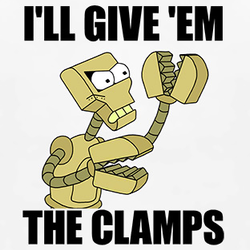 |
| Silly Futurama reference |
 |
| From left: Stepless, worm gear, and worm gear with thumb-twist handle |
Worm Gear
 |
| Indentations left in PVC line after ~1 year under tension |
PROS
- Simple and reliable
- Easy to find
- Virtually infinite adjustability
- Reusable
- Easy to apply and remove
- Requires no special tools (or none at all for thumb-twist)
 |
| Thumb-twist clamp with handle removed |
- Can damage tubing
- Can come loose over time
- Potential to rust shut or jam
- Thumb-twist handle can come off
- Thumb-twist handle might get in the way
Worm gear clamps have a lot going for them, but they're not perfect. Their re-usability comes at the expense of potentially jamming. They will also damage your hoses over time, but this is less of a concern if you have thick-walled lines.
The thumb-twist clamps are a bit more expensive but you won't need a separate tool to open or close them. The downsides are the handles might be in the way on some connections, and if the handle breaks off you'll need a small wrench or a square-drive socket to make adjustments.
Stepless (aka Oetiker)
 |
| Stepless clamp fully open (top) and fully tightened using a clamping tool |
PROS
- More precise tension
- No mechanism to jam
- Won't loosen over time
- Less likely to damage hoses over time
CONS
- Requires a special tool to apply
- Single use - have to destroy clamp to remove it
- Cannot be loosened after its applied
- Narrower diameter range, so you need to find the right size
So Which Is Better? Yes!
It's hard to say one clamp is inherently better than the other. Why pick one when you can use both? I keep both types around and use the one best suited to the job.Worm Gear for Liquid, Temporary Lines
The simple fact that worm gears can be removed makes them great for liquid lines. At some point you will need to disconnect a hose for cleaning and that's much easier to do with a worm gear clamp. This type is a no-brainer for connections you'll be taking apart again and again.
Stepless for Gas, High-Pressure Lines
Stepless clamps are super tight and won't budge, so they are great for gas lines where disassembly for cleaning isn't likely. They are also worth considering on beverage lines that are under high pressure.
No comments:
Post a Comment